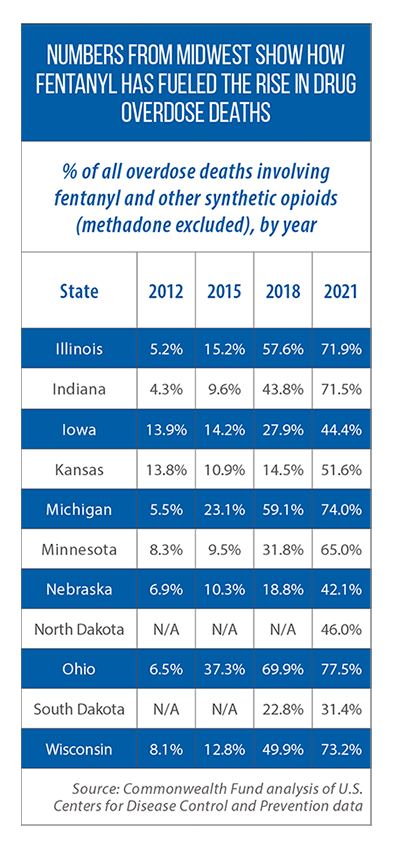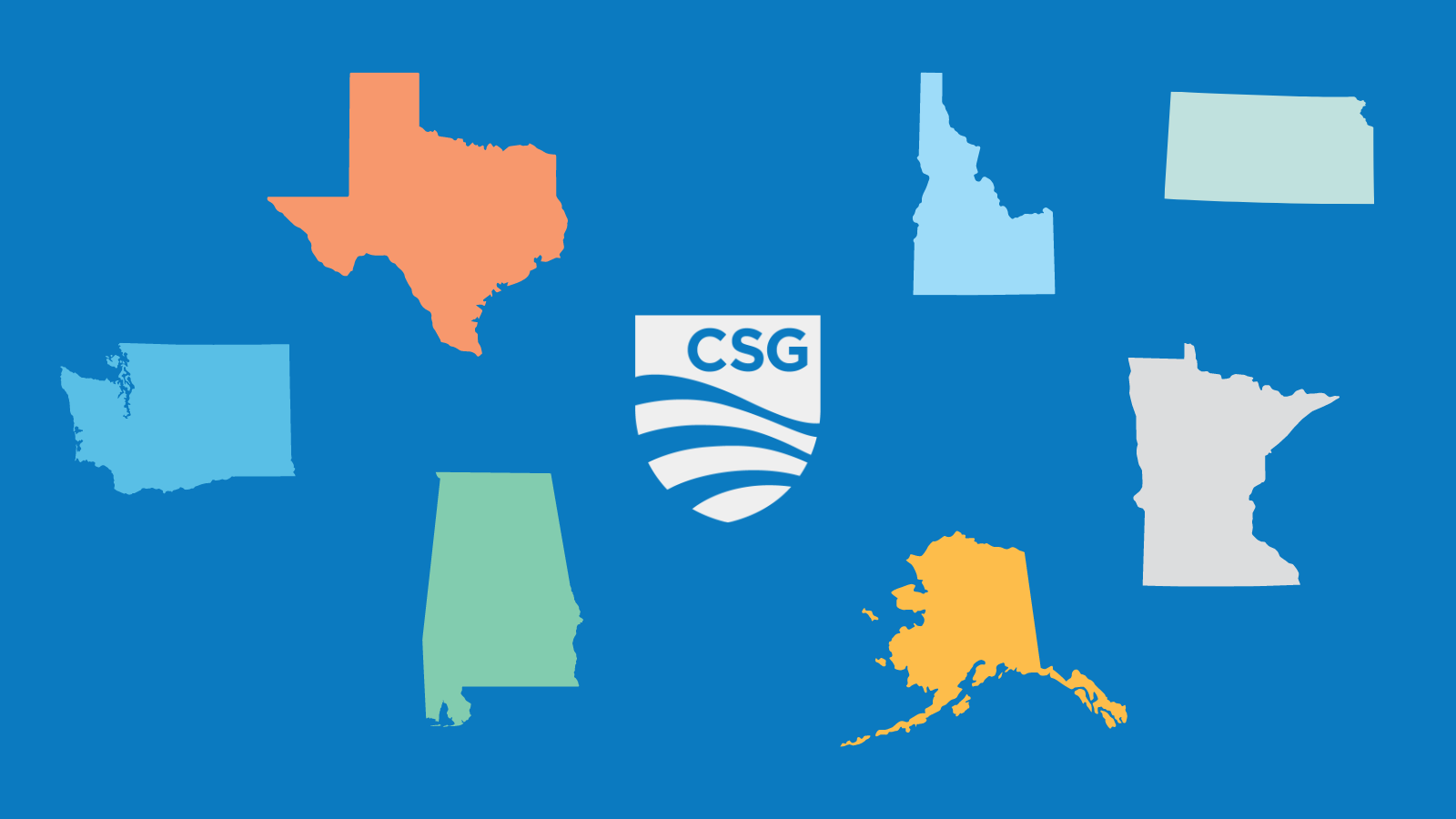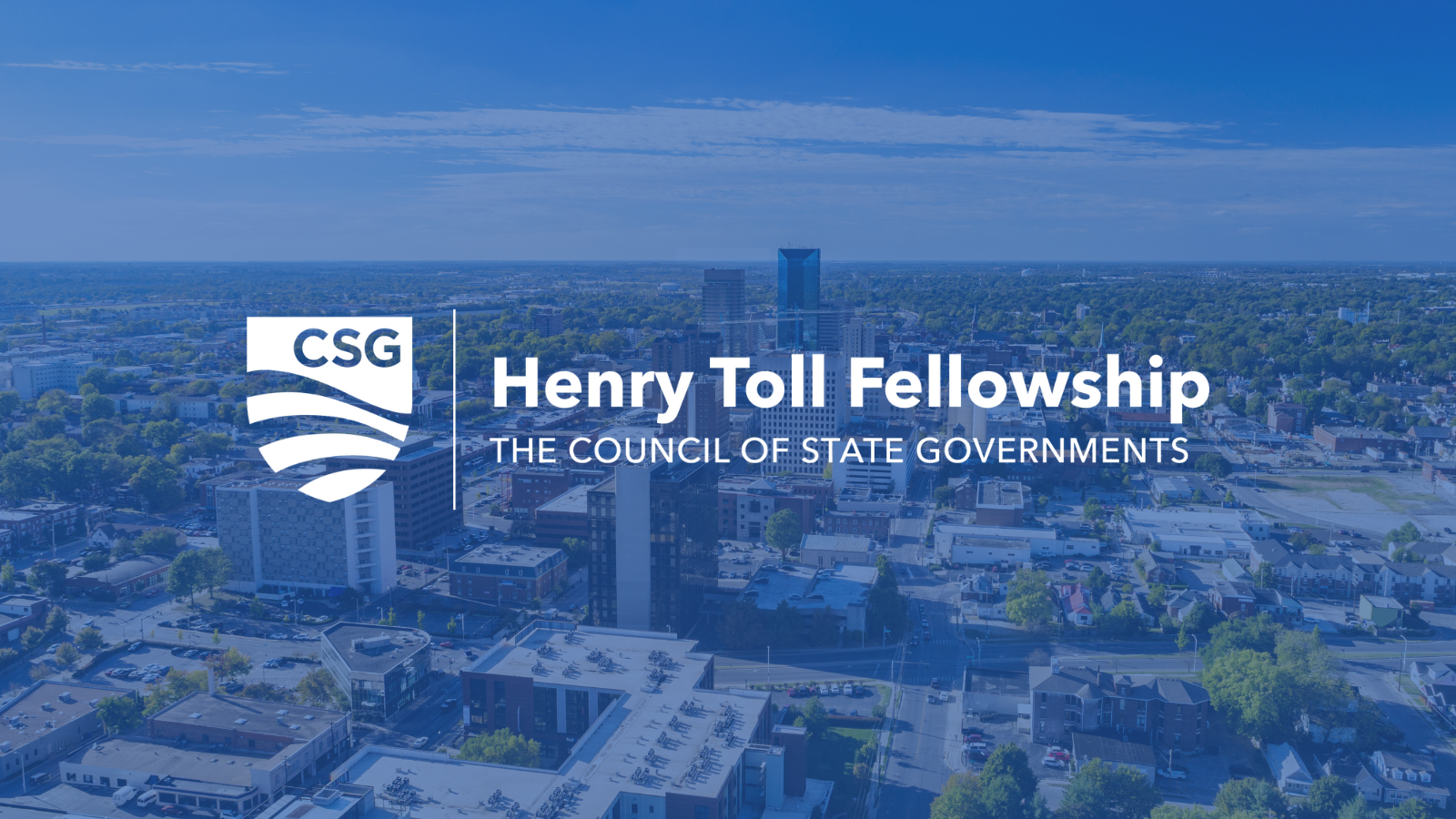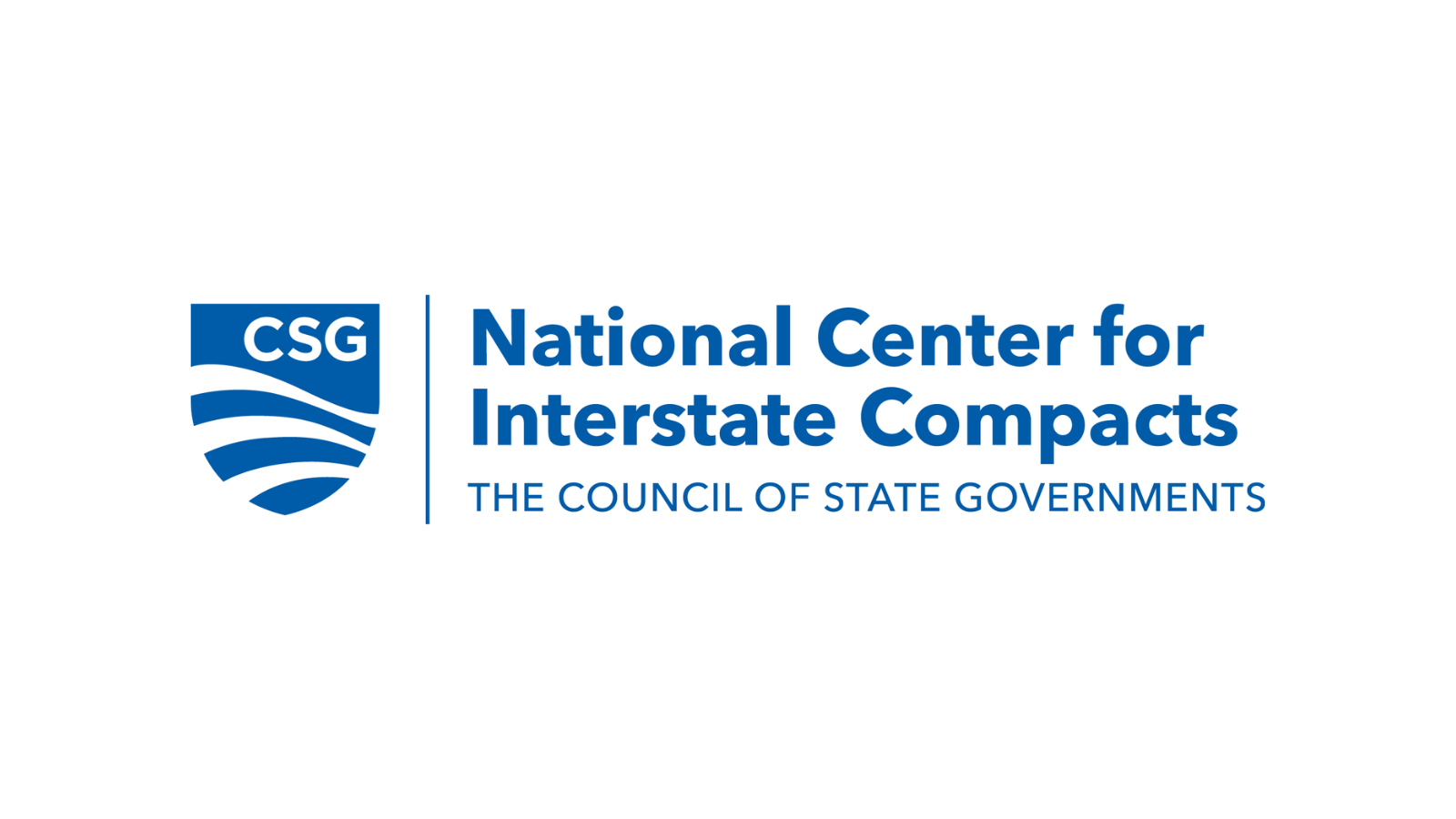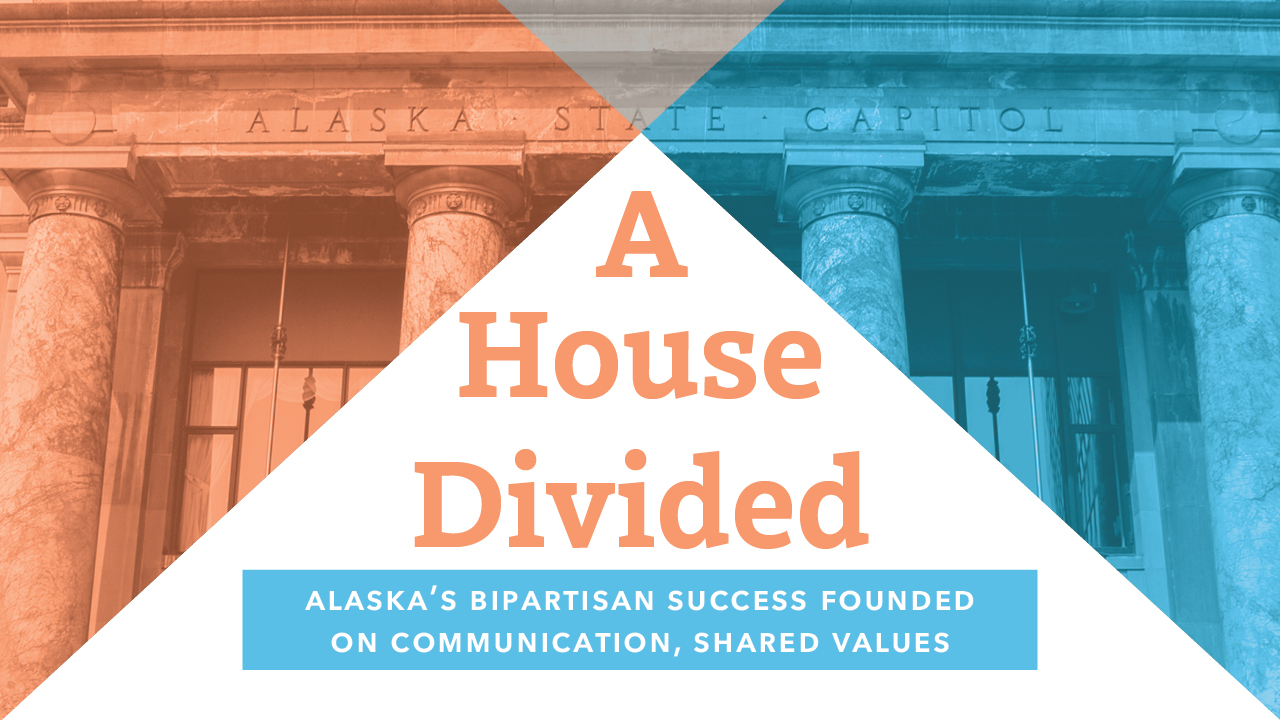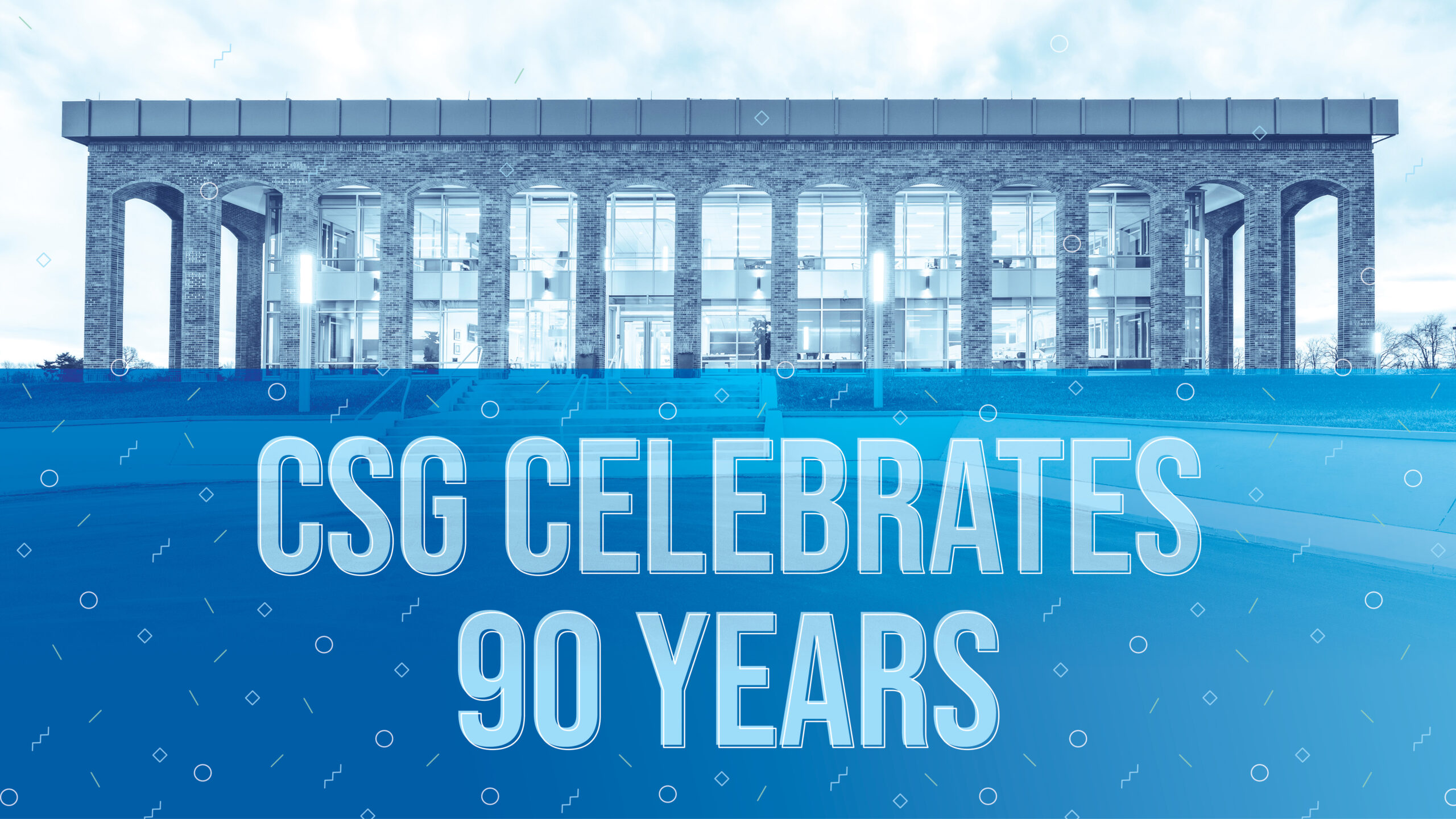Apply Now to Join a Community of Practice on Police-Mental Health Collaboration Staff Wellness
The post Apply Now to Join a Community of Practice on Police-Mental Health Collaboration Staff Wellness appeared first on CSG Justice Center.
The fentanyl threat and legislative response in the Midwest

“Reducing Harm, Increasing Criminal Penalties” ~ PDF
Introduction: ‘Single deadliest drug threat our nation has ever encountered’
In less than a decade’s time, the number of drug overdose deaths in the United States more than doubled, reaching nearly 107,000 by 2021.
One of the striking aspects of this rise has been the increasing role played by fentanyl and other synthetic opioids. They were involved in close to 70 percent of all overdose deaths in 2021, compared to only 6 percent of the fatalities nine years earlier, according to a Commonwealth Fund analysis of federal mortality data. Anne Milgram, head of the U.S. Drug Enforcement Administration, has said that fentanyl “is the single deadliest drug threat our nation has ever encountered.”
This threat has received considerable attention in the Midwest’s state legislatures, with many of the recent legislative proposals taking one of two approaches — and sometimes incorporating a mix of both.
The first approach is “harm reduction”: change a state’s laws or invest in new programs that prevent overdoses by reaching and helping people who use drugs. A second common approach has been to increase criminal penalties related to fentanyl trafficking and/or overdose-related deaths.
This Issue Brief was written by Tim Anderson of the Midwestern Office of The Council of State Governments. It was produced as part of CSG Midwest’s support of two binational, interstate committees of the Midwestern Legislative Conference: the MLC Criminal Justice & Public Safety Committee and the MLC Health & Human Services Committee.
The post The fentanyl threat and legislative response in the Midwest appeared first on CSG Midwest.
Voice for the region: Four policy resolutions adopted by CSG’s Midwestern Legislative Conference
On the final day of this year’s Midwestern Legislative Conference Annual Meeting, participating lawmakers approved four policy resolutions urging federal action on subjects such as border policy, food security and the farm bill.
These resolutions, adopted on July 12, are delivered to leaders in the federal legislative and executive branches of government.
- The MLC’s new policy statement on border policy calls on U.S. Customs and Border Protection to expand hours of operation at several ports of entry. Specifically, legislators want the agency to “immediately adopt the same hours of operation as the Canadian Border Services Agency at these land border ports of entry, or 7 p.m. local time, whichever is later.” The resolution states that early closures “greatly harm cross-border trade, tourism, agriculture production, social relationships and the economies of border communities.”
- A second resolution is built around the MLC Chair’s Initiative of Michigan Sen. Roger Victory — “Food Security: Feeding the Future.” Specifically, legislators note the importance of continuing investments in nutrition incentive programs in the farm bill as well as helping states build up local and regional food infrastructure systems.
- The third resolution urges passage of a new farm bill.
- The fourth resolution endorses the continued support of the relationship and shared interests between member jurisdictions of the MLC and Taiwan.
A bipartisan committee of legislators oversees the MLC’s resolutions process. This committee considers resolutions introduced by individual members of the MLC as well as those supported by various MLC policy committees. Any resolution approved by the Resolutions Committee is then voted on by legislators in attendance at the MLC Annual Meeting. This year’s meeting was held July 9-12 in Detroit.
View all recent MLC policy resolutions »
The post Voice for the region: Four policy resolutions adopted by CSG’s Midwestern Legislative Conference appeared first on CSG Midwest.
Southern Pulse Newsletter, June 2023
GREETINGS MEMBERS,
“The truth is that teamwork is at the heart of great achievement.” – John C. Maxwell
Each and every member of the CSG Staff team, from accounting to our event planners to policy and marketing, has pulled in hundreds of hours of planning and attending to the thousands of details that, when combined together, have created the largest (more than 2500 attendees) Southern Legislative Conference to date. However, we could never pull it off without the tireless work and vision of our host state leadership. To the staff and legislative leaders in South Carolinawho make SLC 2023 possible, we continue to thank you and can’t wait to help you showcase all your beautiful state has to offer.
See you in Charleston!
All the best,
Lindsey
Click here to read Southern Pulse- June 2023
The post Southern Pulse Newsletter, June 2023 appeared first on CSG South.
States Promote Apprenticeships to Expand Career Pathways during 2023 Legislative Session
By Mary Wurtz and Jackson Beauregard
According to the U.S. Chamber of Commerce, there are approximately 9.5 million job openings in the U.S., but only 5.6 million unemployed workers to potentially fill those roles. Considering these workforce shortages, many states pursue opportunities to expand work-based learning and to invest in upskilling existing workers through registered apprenticeship.
A registered apprenticeship is a high-quality, industry-driven career pathway that combines paid on-the-job training with classroom instruction to prepare workers for skilled careers in a variety of occupations. Historically, apprenticeships have been associated with trade professions, but now more than 1,000 occupations have been approved for registered apprenticeship by the U.S. Department of Labor, including roles in nursing, information technology, cybersecurity, human resources and more.
Registered apprenticeship programs can help states to address workforce shortages by empowering employers to grow their own talent pipelines. Through apprenticeship, employers invest directly in employees by providing training both on the job and in the classroom and mentorship by pairing apprentices with skilled mentors who support them throughout the program. Because apprentices learn while they work, programs typically have few to no minimum experience requirements. This makes apprenticeship programs a great tool for recruiting individuals who have traditionally faced barriers to employment and postsecondary training, like formerly incarcerated individuals or individuals with disabilities.
Throughout the 2023 legislative session, several states adopted strategies to expand registered apprenticeships, such as establishing apprenticeship grant programs, promoting the use of apprenticeships in previously non-apprenticeable occupations and providing additional benefits to individuals in apprenticeship programs.
Texas introduced HB 3723 (2023), which would establish a Rural Workforce Training Grant Program providing targeted funding for job-specific training, including apprenticeship programs, in counties with a population of less than 200,000. Grant money may be used to cover “costs associated with training materials, instructors’ fees, participant wraparound expenses, facility fees, administrative costs, and outreach, mentoring, and recruiting costs” for apprenticeships and other training programs.
Kansas enacted HB 2292 (2023), which establishes multiple grant funds and tax credits for employers offering apprenticeships in a variety of fields, including:
- A tax credit of up to $2,500 per apprentice for employers of apprentices in registered apprenticeship programs, up to 20 apprentices per employer. An additional tax credit of $500 is available per apprentice enrolled in a secondary or postsecondary career and technical education program.
- The Kansas Nonprofit Apprenticeship Grant Program Fund, offering $2,750 per apprentice to “eligible nonprofit employers and nonprofit healthcare employers,” with up to 20 apprentices per employer.
- The Kansas Educator Registered Apprenticeship Grant Program, established to fund tuition, fees, books and materials for education apprentices pursuing postsecondary education degrees. Education apprentices in Kansas can receive up to $2,750 per year for the purpose of increasing the number of qualified, credentialed teachers in the state of Kansas.
Idaho enacted SB 1069 (2023), which amends existing law to enable the State Board of Education to issue a certificate to a teacher who completed an approved registered apprenticeship program. These amendments create the possibility of state developed apprenticeship programs that meet the same standards as traditional teacher preparation programs and will be targeted toward individuals who have not earned bachelor’s degrees. Education degrees are often costly, and requirements of traditional programs, like unpaid student teaching, dissuade many individuals from pursuing their teaching certifications. Idaho is now one of more than a dozen states utilizing paid teacher apprenticeships to address these challenges.
Additionally, Idaho passed HB 16 (2023), which removes barriers for state agencies when hiring apprentices to fill public workforce shortages. Under new legislation, state agencies will be able to hire apprentices to fill shortages without counting them toward their annual budgeted full-time equivalent caps.
Washington enacted HB 1525 (2023), which expands the state’s existing child care subsidies to include individuals participating in a state registered apprenticeship program. Previous bill language included those in a registered apprenticeship, but the individual also needed to be a full-time student. Now, those who are in an apprenticeship program but are not students may receive the child care benefit. Apprentices are eligible to receive child care benefits for the care of one or more eligible children for the first 12 months of their enrollment in a registered apprenticeship program, if the individual’s annual adjusted household income does not exceed 75% of the state median income.
Minnesota enacted HF 1937 (2023), which increases the reimbursement amount that eligible service members and their family members are entitled to receive for costs associated with apprenticeship programs and other on-the-job training programs. The new law increases the aggregate amount of reimbursement from $10,000 to $15,000 over the eligible person’s lifetime, or a total of $3,000 per fiscal year. This reimbursement is in addition to benefits provided under the federal G.I. Bill, which provides funding for books, supplies and housing to veterans in approved apprenticeship programs.
These pieces of legislation build on the work accomplished by states in previous years to expand their apprenticeship systems. For example, in 2019, Alabama passed HB 570, which eliminated barriers to obtaining an occupational license by completing an apprenticeship program. Under the 2019 legislation, individuals who complete an apprenticeship may be granted an occupational license in that trade if the individual also completes all necessary examinations and meets other statutory requirements. The law also states that individuals who complete apprenticeship programs may not be required to complete additional testing requirements, affirming apprenticeships as high-quality preparatory programs for occupational licensure examinations.
Additionally, in 2022, Alaska passed HB 114, which directs the Department of Education and Early Development to “provide educational opportunities in the areas of vocational education and training and basic education to individuals over 16 years of age who are no longer attending school.” This includes encouraging engagement with “businesses and labor unions to develop a program to prepare students for apprenticeships or internships that will lead to employment opportunities.”
As states continue to expand their apprenticeship systems to build new career pathways, The Council of State Governments education and workforce team is available as a resource for policymakers. CSG provides states with no-cost technical assistance on registered apprenticeship, work-based learning and other topics related to workforce development. CSG can also help states to develop registered apprenticeship programs in state and local government to address their own public sector workforce needs.
For more information, contact CSG Policy Analyst Mary Wurtz via email at [email protected].
CSG Names 43 Outstanding Leaders to the 2023 Class of Henry Toll Fellows
Government officials from all branches of state government will participate in the national leadership development program
The Council of State Governments (CSG) selected 43 state leaders representing 27 of the states and U.S. territories and from across all branches of government as members of the 2023 class of CSG Henry Toll Fellows, the nation’s premier leadership development program for state government officials.
Since 1986, CSG has annually convened a new class of CSG Henry Toll Fellows at its national headquarters in Lexington, Kentucky, for an intensive leadership boot camp. The program’s sessions are designed to stimulate personal assessment and growth, empower leaders to collaborate and communicate more effectively, and provide nonpartisan networking and relationship-building opportunities.
“While the CSG Henry Toll Fellows come from every region of our nation, from both political parties and all three branches of state government, they share one thing in common — they are all people of purpose with a passion for public service,” said CSG Executive Director/CEO David Adkins, a former Kansas state senator and 1993 CSG Henry Toll Fellow alumnus. “Toll Fellows are selected based on their demonstrated commitment to solve problems, to work collaboratively to get things done, and their belief that state government can and must be a force for good.”
Toll Fellows are nominated by their peers and selected by alumni of the program.
“The selection committee looks for leaders who have already demonstrated excellence in public service but who also show promise for continuing to make a difference in the future,” Adkins said.
There are more than 1,350 graduates of the Toll Fellowship, including five state/territorial house speakers, three sitting state supreme court justices, 10 sitting members of Congress, five sitting governors and more than 200 Toll alumni currently serving as state/territorial legislators.
The Fellowship honors the founder of CSG, Henry Toll, who, as a former state senator from Colorado, was the driving force behind the creation of CSG in 1933.
“Each class of Toll Fellows has a different energy, and we are excited to see this year’s dynamic,” said Lorna Patches, deputy director of membership and leadership development at CSG. “Everyone in this group is a leader in their home state, which provides a tremendous opportunity for attendees to learn and grow through interaction with each other. The CSG experience provides a framework for shared conversations, which begin with our time together and extend for lifetimes.”
For more information on the CSG Henry Toll Fellowship, visit: csgovts.info/tolls23 or email [email protected].
CSG 2023 Toll Fellowship Class
- House Majority Floor Leader Abraham M. Aiyash, Michigan
- Rep. Otis L. Anthony, Mississippi
- Rep. Debra Bazemore, Georgia
- Rep. Scott Beck, Vermont
- Rep. Alyssa Black, Vermont
- Senate Assistant Minority Leader Hearcel F. Craig, Ohio
- Sen. Kirk Cullimore, Majority Assistant Whip, Utah
- Bryan Echols, Senior Advisor & Deputy Director of Impact Investments, State Treasurer Banking Division, Illinois
- House Deputy Majority Leader Kate Farrar, Connecticut
- Eric Forcier, Deputy Secretary, Secretary of State’s Office, New Hampshire
- Rep. Denise Garner, Arkansas
- Sen. Rod G. Hickman, Mississippi
- Rep. Dayan Hochman-Vigil, New Mexico
- Rep. Shelly Hutchinson, Georgia
- Tania Hytrek, Operations Administrator, Legislative Service Office, Wyoming
- Rep. Jamie J. Johnson, Missouri
- Rep. Shannon Roers Jones, North Dakota
- Sen. Cory McCray, Deputy Majority Whip, Maryland
- Sen. T’wina Nobles, Majority Whip, Washington
- Rep. William Notte, Vermont
- Sen. Brian G. Pettyjohn, Minority Whip, Delaware
- Rep. Mari-Lynn S. Poskin, Kansas
- Rep. Melissa Provenzano, Oklahoma
- Rep. Rebecca Reimer, Majority Whip, South Dakota
- Sen. Denise Ricciardi, New Hampshire
- Rep. Tristan D. Roberts, Vermont
- Rep. Amy Roeder, Maine
- Sen. Kristin Roers, North Dakota
- Rep. Cindy Ryu, Washington
- Rep. Suzanne Salisbury, Maine
- Senate Majority Leader Amanda Lee Shelton, Legislative Secretary, Guam
- Rep. Matthew Paul Simpson, Alabama
- Sen. Mark Spreitzer, Wisconsin
- Sara E. Stolt, Deputy Commissioner, Department of Health & Human Services, North Dakota
- Sen. Brandon J. Storm, Kentucky
- Rep. Holly B. Stover, Maine
- Rep. Laura D. Supica, Maine
- Rep. Jordan Teuscher, Utah
- House Deputy Majority Leader My-Linh Thai, Washington
- Jason W. Thompson, Senior Assistant Revisor of Statutes, Office of Revisor of Statutes, Kansas
- House Speaker Cathy L. Tilton, Alaska
- Senate Minority Leader Melissa Wintrow, Idaho
- Justice Briana H. Zamora, Supreme Court, New Mexico
Check out 2023’s fourth issue of Capitol Ideas magazine to learn more about the 36th class of fellows: https://csgovts.info/ci_issue_4_2023_toll_fellows.
About The Council of State Governments
The Council of State Governments is our nation’s only organization serving all three branches of state government. CSG is a region-based forum that fosters the exchange of insights and ideas to help state officials shape public policy. This offers unparalleled regional, national and international opportunities to network, develop leaders, collaborate and create problem-solving partnerships. For more information about The Council of State Governments, visit csg.org.
Interstate Teaching Mobility Compact Enacted Allowing Streamlined Licensing Pathways for Educators in 10 States
Licensing for the roughly 3.7 million teachers in the country has historically been a system with unclear barriers between states, making it difficult for educators to relocate and attain a teaching license in another state. Military spouses are particularly impacted by these limitations — they move residences between states frequently as their spouses are relocated to various posts and are often met with licensing barriers.
Recognizing these obstacles, in 2020 the Department of Defense entered into a cooperative agreement with The National Center for Interstate Compacts at The Council of State Governments. Authorized by Congress in the 2020 National Defense Authorization Act, the cooperative agreement provides funding for the development of up to ten new occupational licensure compacts. A compact for teachers was a priority for the Department of Defense.
Model legislation to join the Interstate Teacher Mobility Compact was released to states in November 2022 after more than a year of development, public comment and stakeholder review. In June, Oregon joined nine other states — Colorado, Utah, Kentucky, Oklahoma, Kansas, Florida, Alabama, Nebraska and Nevada — in fully enacting the compact legislation. With the addition of this tenth state, the compact became active — the fastest occupational licensure compact to do so.
“A military spouse shouldn’t have to choose between supporting their family and pursuing their profession. Thankfully, states are working together to ensure they won’t have to,” said David Adkins, executive director/CEO of The Council of State Governments.
“The ten states that have already enacted the Interstate Teacher Mobility Compact are reducing barriers to mobility for licensed teachers, and that’s good news to the many teachers in military families who will move to those states. CSG is proud to work with state officials and honored to partner with the U.S. Department of Defense to help create new tools to support military families. We look forward to continuing to be a resource for the ITMC Commission and its member states.”
Maintaining state sovereignty is one of the cornerstones of the Interstate Teacher Mobility Compact. The compact does not alter member states’ ability to regulate the teaching profession or teacher licensure. Member states take on some responsibility to grant licenses to out-of-state teachers, but any standing pathways to teacher licensure within the state will remain in place.
Addressing Teacher Shortages
While districts across the country are facing widespread teacher shortages, the Teacher Mobility Compact streamlines the systems of licensure mobility in member states.
“Teachers who relocated can find it difficult to navigate the waters of license issuance in a new state,” said Jimmy Adams, executive director of the National Association of State Directors of Teacher Education and Certification. “Many of these are professionals with years of experience who decide to leave the profession because of the barriers they confront.”
The teaching compact utilizes a different model than other interstate occupational licensure compacts. Compact member states submit licenses that are eligible for the compact and meet a set of criteria outlined in the legislation. To be eligible, a license must require a bachelor’s degree and completion of a state-approved program for teacher licensure like a teacher preparation program at a college or university. Teachers holding a compact-eligible license can apply for licensure in another member state and receive the closest equivalent license without submitting additional materials, taking state-specific exams or completing additional coursework.
This compact maintains each member state’s standards while recognizing the professional who holds this high-level license,” Adams said. “This compact will keep many teachers in the profession who may otherwise leave.”
Next Steps
Later this year, the compact member states will nominate their commissioners and the first meeting of the Interstate Teacher Mobility Compact Commission will be held to draft the bylaws and rules of the compact.
Currently, several states are still considering legislation to join the teaching compact. Those who join will also be included in this meeting if the legislation is passed before the first convening.
For more information about the Interstate Teacher Mobility Compact or to view the model legislation, visit teachercompact.org. To learn more about the National Center for Interstate Compacts and other occupational licensure compacts, visit compacts.csg.org.
About Occupational Licensure Interstate Compacts
Occupational licensure compacts create reciprocity between states while maintaining the quality and safety of services and protecting state sovereignty. Compacts result in a more efficient distribution of licensed workers by supporting practitioner mobility.
In addition to its work with the Department of Defense, the CSG National Center for Interstate Compacts led the development of interstate compacts for physicians, nurses, emergency medical services personnel, physical therapists, psychologists, occupational therapists, licensed professional counselors and audiologists/speech-language pathologists. More than 40 states and territories have adopted at least one of the compacts and over half have adopted three or more.
About CSG and the National Center for Interstate Compacts
Founded in 1933, The Council of State Governments is the nation’s only organization serving all three branches of state government. CSG is a region-based forum that fosters the exchange of insights and ideas to help state officials shape public policy. This offers unparalleled regional, national and international opportunities to network, develop leaders, collaborate and create problem-solving partnerships. Learn more at csg.org.
CSG has more than 75 years of experience promoting multi-state problem solving and advocating the role of the states in determining their respective futures. The National Center for Interstate Compacts is a policy program developed by CSG to assist states in developing interstate compacts, which have proved to be an effective mechanism for states to jointly problem solve. Learn more at compacts.csg.org.
A House Divided
By Lexington Souers
Pennsylvania and Virginia, much like Congress, have split chambers with the House and Senate led by each respective party. Five other states — Alaska, Arizona, Michigan, Minnesota and New Hampshire — have a near or total party split within either one or both chambers.
With split chambers, legislators face unique challenges when compromising and collaborating on legislation.
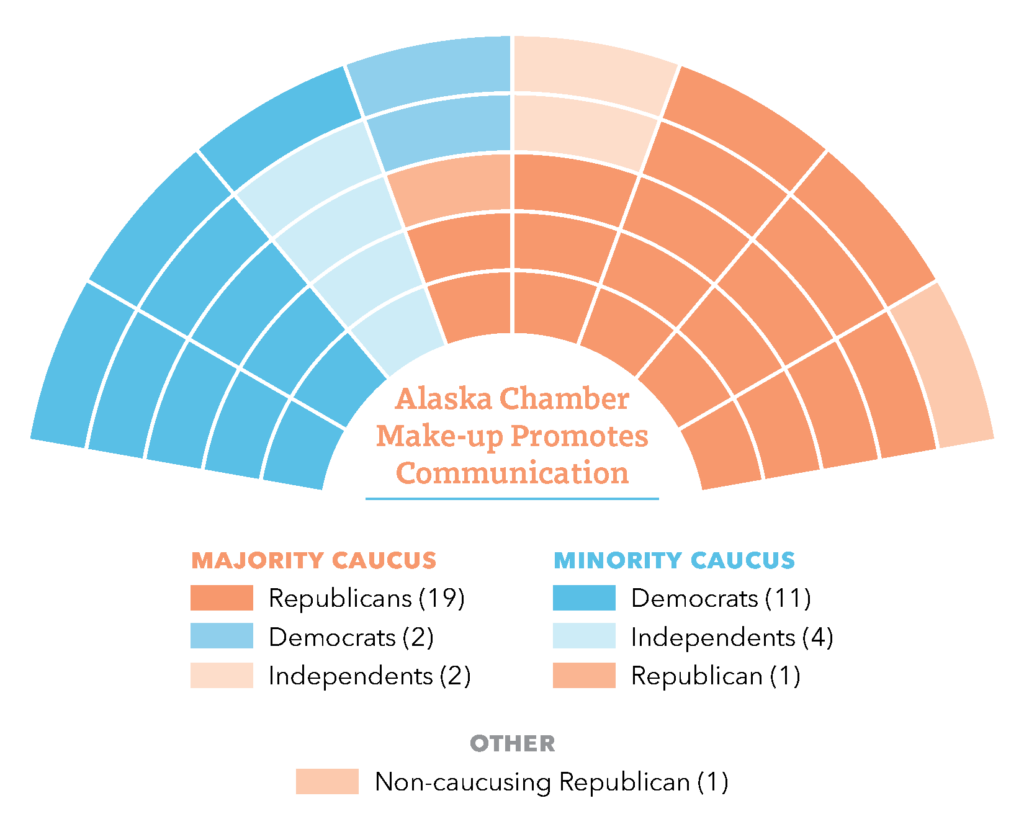
The 49th state, with thriving waterways, sweeping mountain views and distinct detachment from the contiguous U.S., has a history of coalition building, according to Alaska House Minority Leader Calvin Schrage. Because parties lack a definite voting majority or minority, Alaskan legislators join across party lines, creating coalitions made up of likeminded individuals, with more emphasis placed on values and fiscal policy.
“It’s not trying to necessarily achieve a party agenda but trying to meet your unique needs in unique districts. When you then try and form a majority or minority around the party issues, it just doesn’t work,” Rep. Schrage said. “So you see a lot of work going into trying to find what values and what issues can we find a majority support around. That’s where in the last Legislature, and in this Legislature, we have coalition governments that are formed much more around values and fiscal policy than you do around party identity.”
Rep. Cathy Tilton, Alaska’s House speaker, noted a bipartisan partnership allowed the Legislature to serve Alaskans effectively, especially because of Juneau’s geographical location, which may keep citizens from participating in traditional government activities.
“Over the last several years, it’s taken a long time for the House, specifically, to organize because it’s so split,” Tilton said. “One of the goals was to organize in a timely manner because Alaskans are really frustrated with sending their representatives to Juneau. … Fortunately, we found alignment with the [Alaska House] Bush caucus, or the more rural partners, to organize. We’re able to do that on the second day of session.”
The minority party is also comprised of Democrats, Republicans and independents, which Schrage credits as being “vital” to the legislative process. By uniting around shared values, rather than strict party identity, Schrage said the coalition can work together. However, he recognizes that each member has legislation they are passionate about, which may not align with the coalition as a whole.
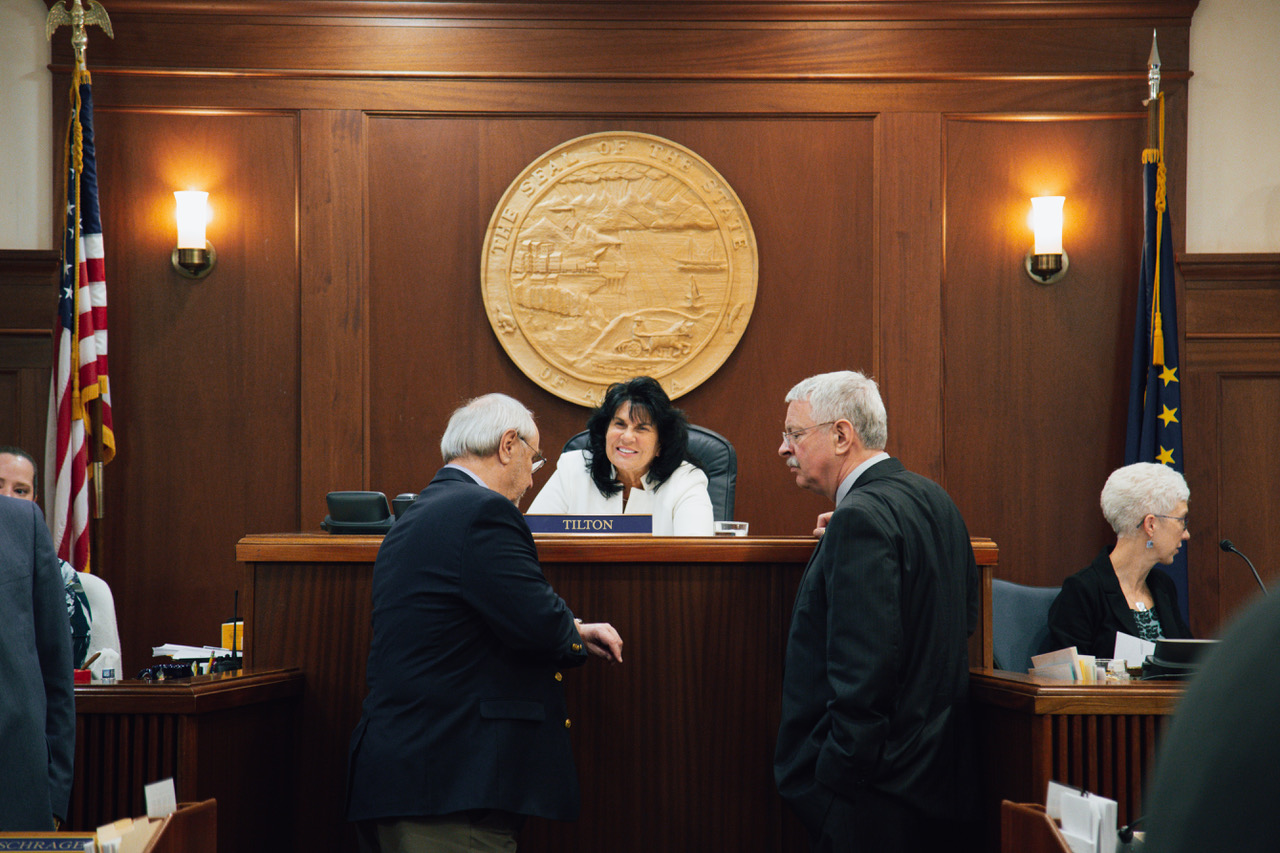
“If it’s something that support isn’t there, individual members need to do the work of finding a way to meet those diverse members where they are,” Schrage said. “For those issues, individual members have to do a lot of work and kind of figure out how they can tailor their legislation to meet that very unique political identity of the Alaskan Legislature. There’s a much greater appetite in Alaska to pass bills out across party lines, or across caucus lines. That’s just something that I think is inherent in a close Legislature like this. You don’t have votes to spare within your own caucus, and sometimes you’re going to have to work across those lines to find a path forward.”
To do this, both Schrage and Tilton emphasize communication.
“You do that with just respectful communication and bringing back respect to this institution, which means that we need to communicate with each other,” Tilton said. “We can agree to disagree. I may not support your bill and you may not support my bill. That’s okay. We can still work together.”
— Rep. Cathy Tilton, Alaska House Speaker
Schrage noted how communication can assist with better understanding what values members align on and how those with differences can comfortably work together and make incremental progress. He added that communication also helps address potential roadblocks in legislation, which can be more easily achieved by straying from “typical political messaging” and clearly explaining bills to fellow legislators to find common ground.
“See where there’s some alignment on those values and recognize that because the chamber is so split, you don’t have that kind of party strength that you might have in other states,” Schrage said. “We all really have to moderate our expectations and be willing to make incremental progress. Accept that and do not let perfect be the enemy of good.”
— Rep. Calvin Schrage, alaska House Minority Leaders
From this communication, members build strong relationships, regardless of party identity. Tilton said the relationships she built led to some of her favorite memories from her time in the Legislature. Among them was her past work as House minority leader with Alaska Sen. Tom Begich, who was then Senate minority leader. Despite standing on opposite sides of the aisle, Tilton and Begich established a close relationship that helped meet the needs of the minority parties.
“I don’t know that if you were out in the real world that you would have that opportunity to build a relationship, and what I would call it true friendship, with somebody who was on the other side of the aisle from you,” Tilton said.
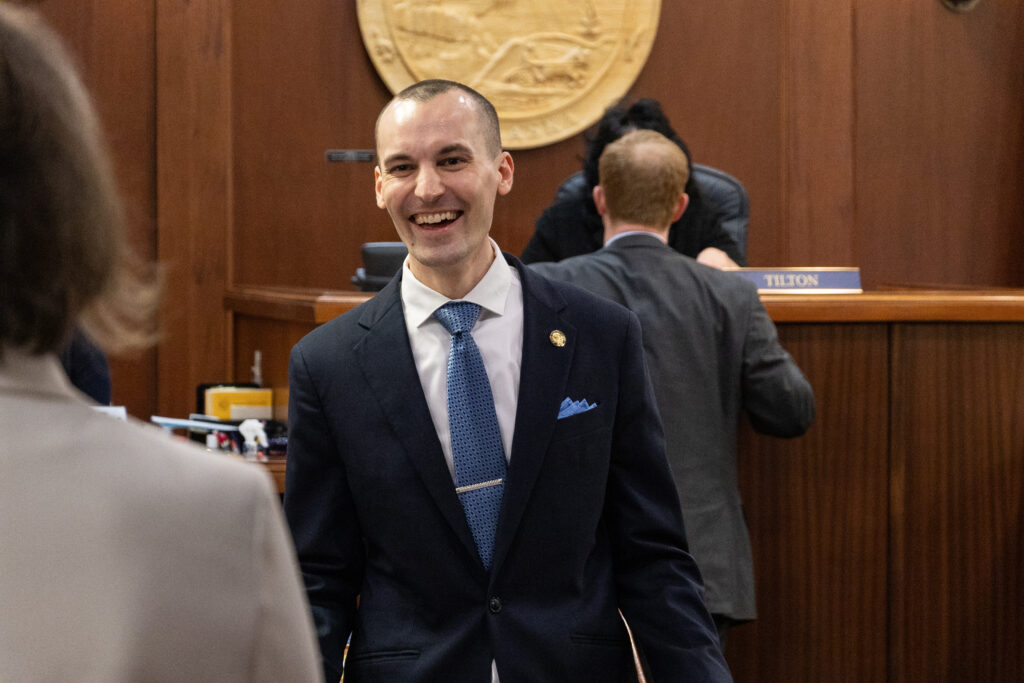
Photo credit: Graham Judson
“Member-to-member communication” and relationships build trust and familiarity, according to Schrage. The role of legislator also allows him to meet and engage with individuals who are “experts in their fields.” The result of those relationships can lead to effective policy work and coalition building — both now and in the future.
As speaker, Tilton said she recognizes her role as a “leader of leaders,” regardless of party identity.
“I realize that my responsibility is to be the speaker of the entire House. I have to take in and listen to the needs of all of the members here,” Tilton said. “Because they were all elected in their districts to be a leader, just like I am that leader. Being a leader of leaders is a fine balance.”
This balance often leads to compromise, which Tilton said can be difficult when “everyone has a different idea” of what major legislation like the annual budget will look like. These types of decisions can have a lasting impact on Alaska, which is why Tilton believes she — and those in similar positions — must make every effort to acknowledge the needs and wants of every member.
Both Schrage and Tilton highlighted the importance of passing a budget that addresses the distinct financial challenges found in Alaska, like the reliance on natural resource revenue and the question of implementing broad taxes.
“A lot of the discussion surrounding organization of the majority and minority caucuses are around what you view as the right fiscal solution for the state, so you don’t see a lot of compromise,” Schrage said. “As you face challenges, or as you see the need to negotiate on fiscal issues, the focus is really on consensus building, education and discussion. We have a large amount of time and energy focused around really making sure that members are communicated with and that everyone has an opportunity to speak to their districts’ needs, to be heard and to have a say in that process.”
While the budget remains a complicated compromise, other legislation illustrated the benefits of bipartisan support. Schrage said Senate Bill 58, which extends postpartum Medicaid coverage to 12 months, is a key piece of bipartisan legislation. The relationship between respect and bipartisan success remains vital in this session and beyond, the speaker added.
“I think we’ve done great things with the bills that we’ve had,” Tilton said. “But more than looking at creating laws, I think that it’s just important that you’re building good relationships. I think it goes back to how you have to be true to yourself and respect yourself, but you also need to respect the other person that you’re working with.”



